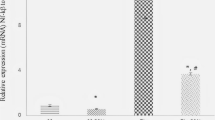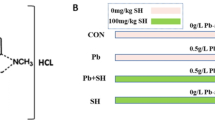Abstract
Lead acetate-motivated oxidative stress can affect all organ systems, particularly the liver. Glutamine (Gln) has both antioxidant and chelating properties. Therefore, we investigated for the first time the effect of Gln on the biochemical and histopathological alternations in a rat model of lead toxicity. Thirty-two rats were divided into four groups (eight rats in each): untreated normal, lead poisoning, and two similar groups receiving Gln (0.1% in drinking water for 4 weeks). To induce lead poisoning, rats received 50 mg/L lead acetate in drinking water for 4 weeks. Oxidative stress indices (total glutathione, the ratio of reduced glutathione to oxidized glutathione, advanced protein oxidation products, malondialdehyde, and ferric ion reducing power) and inflammatory markers (hepatic nuclear factor-kβ expression, interleukin 1β level, and myeloperoxidase activity) were measured. Furthermore, biochemical markers of hepatotoxicity (alanine transaminase, aspartate transaminase, alkaline phosphatase, gamma-glutamyl transpeptidase, total bilirubin, total protein, albumin, and globulins) were measured. Histopathological examination evaluated lead-induced liver damage. The treatment compensated lead-induced biochemical and histopathological alternations in rat liver. Furthermore, it decreased lead acetate level, the NF-kβ gene expression, oxidative stress, and inflammatory markers. Moreover, the treatment elevated total glutathione and reduced glutathione in the sera and liver homogenates of treated groups (p < 0.001). Glutamine could protect the liver against lead intoxication via antioxidant, anti-inflammatory, and chelating properties. In addition, its downregulating effect on the hepatic NF-kβ signaling pathway confirms its hepatoprotective activity.


Similar content being viewed by others
References
Gato W, Rversole E, Means J (2009) Assessing lead effect on Fisher-344 rats using ICP-MS and histology. J Toxicol Chem 6(2):1–11
Hedayati AD, Darabitabar F (2017) Lethal and sub-lethal impacts of lead on some hematological, biochemical and immunological indices in Caspian roach (Rutilus rutilus). Pollution 3(1):21–27
Jan ATA, Azam M, Siddiqui K, Ali A, Choi I, Haq QMR (2015) Heavy metals and human health: mechanistic insight into toxicity and counter defense system of antioxidants. Int J Mol Sci 16(12):29592–29630
Patrick L (2006) Lead toxicity part II: the role of free radical damage and the use of antioxidants in the pathology and treatment of lead toxicity. Altern Med Rev 11(2):114–127
Gehrke NS, Schattenberg JM (2020) Metabolic inflammation-a role for hepatic inflammatory pathways as drivers of comorbidities in nonalcoholic fatty liver disease? Gastroenterology 158(7):1929-1947.e6
Piuri G et al (2020) Methylglyoxal, glycated albumin, PAF, and TNF-α: possible inflammatory and metabolic biomarkers for management of gestational diabetes. Nutrients 12(2):479
Sun B, Karin M (2008) NF-kB signaling, liver disease and hepatoprotective agents. Oncogene 27:6228–6244
Flora SJP, Pachauri V (2010) Chelation in metal intoxication. Int J Environ Res Public Health 7:2745–2788
Mohamed RS, Fouda K, Akl EM (2020) Hepatorenal protective effect of flaxseed protein isolate incorporated in lemon juice against lead toxicity in rats. Toxicological Reports 7:30–35
Fontana Gallego L, Saez Lara MJ, Santisteban Bailón R, Gil Hernandez A (2006) Nitrogenous compounds of interest in clinical nutrition. Nutr Hosp 21:15–29
Mahdavifard SN, Nakhjavani M (2019) Effect of glutamine on oxidative stress, inflammatory, and glycation markers, and the activity of glyoxalase system in diabetic rats with atherosclerosis. J Mazandaran Univ Med Sci 28(170):33–42
Lin ZC, Cai F, Lin N, Ye J, Zheng Q, Ding G (2014) Effects of glutamine on oxidative stress and nuclear factorκB expression in the livers of rats with nonalcoholic fatty liver disease. Exp Ther Med 7(2):365–370
Mansour A, Mohammad MTR, Qorbani M, Heshmat R, Larijani B, Hosseini S (2015) Effect of glutamine supplementation on cardiovascular risk factors in patients with type 2 diabetes. Nutrition 31(1):119–126
Welbourne TC (1979) Ammonia production and glutamine incorporation into glutathione in the functioning rat kidney. Can J Biochem 57:233–237
Jalali M (2020) Effect of iron-amino acid chelates on antioxidant capacity and nutritional value of soybean. Plant Productions 43(4):477–486
Kim JL, Lee Y, Yang M (2014) Environmental exposure to lead (Pb) and variations in its susceptibility. J Environ Sci Heal Part C Environ Carcinog Ecotoxicol Rev 32:159–185
Comar JF, de Olier DS, Bracht L, Kemmelmeier FS, Peralta RM, Bracht A (2016) The metabolic responses to L-glutamine of livers from rats with diabetes types 1 and 2. PLoS One 11(8):e0160067
Taylor EL, Armstrong KR, Perrett D, Hattersley AT, Winyard PG (2015) Optimisation of an advanced oxidation protein products assay: its application to studies of oxidative stress in diabetes mellitus. Oxid Med Cell Longev 2015:496271
Benzie IFS, Strain JJ (1996) The ferric reducing ability of plasma (FRAP) as a measure of “antioxidant power”: the FRAP assay. Anal Biochem 239(1):70–76
Begic AD, Duric A, Gobeljic B, Stevanovic I, Lukic V, Stanojevic I, Ninkovic M, Saso L, Vojvodic D, Mirjana D (2017) The simple isocratic HPLC—UV method for the simultaneous determination of reduced and oxidized glutathione in animal tissue. Acta Chromatogr 29(1):67–84
Ceron JJT, Tecles F, Tvarijonaviciute A (2014) Serum paraoxonase 1 (PON1) measurement: an update. BMC Vet Res 10:74
Aaebi H (1984) Catalase in vitro. Methods Enzymol 105:121–129
Mahdavifard S, Dehghani R, Jeddi F, Najafzadeh N (2021) Thiamine reduced metabolic syndrome symptoms in rats via down-regulation of hepatic nuclear factor-kβ and induction activity of glyoxalase-I. Iran J Basic Med Sci 24:46–53
Kavita S, Neerja R, Khushboo G, Saurabh S (2017) Probable benefits of green tea with genetic implications. J Oral Maxillofac Pathol 21:107–114
Sharma V, Kansal L, Sharma A (2010) Prophylactic efficacy of Coriandrum sativum (coriander) on testis of lead-exposed mice. Biol Trace Elem Res 36:337–354
Gill SST, Tuteja N (2010) Reactive oxygen species and antioxidant machinery in abiotic stress tolerance in crop plants. Plant Physiol Biochem 48(12):909–930
Chen CL, Lin B, Qi S, He J, Zheng H (2019) Protective effects of salidroside on lead acetate-induced oxidative stress and hepatotoxicity in sprague-dawley rats. Biol Trace Elem Res 191:426–434
Mabrouk AS, Sala IBH, Chaieb W, Cheikh HB (2016) Protective effect of thymoquinone against lead-induced hepatic toxicity in rats. Environ Sci Pollut Res 23:12206–12215
Narjes Beheshti FG, Sepehri H (2015) Effect of vitamin C and quercetin treatment on the liver histopathologic profile in congenital lead exposed male rat pups. Physiol Pharmacol 10:46–52
Gao D, Madi M, Ding C, Fok M, Steele T, Ford C et al (2014) Interleukin-1beta mediates macrophage-induced impairment of insulin signaling in human primary adipocytes. Am J Physiol Endocrinol Metab 307:289–304
Piuri G, Basello K, Rossi G, Soldavini CM, Duiella S, Privitera G, Spadafranca A, Costanzi A, Tognon E, Cappelletti M, Corsetto PA, Rizzo AM, Speciani AF, Ferrazzi E (2020) Methylglyoxal, glycated albumin PAF, and TNF-α: possible inflammatory and metabolic biomarkers for management of gestational diabetes. Nutrients 12(2):479
Demir M et al (2007) Liver lipid peroxidation in experimental Escherichia coli peritonitis: the role of myeloperoxidase and nitric oxide inhibition. Med Sci Monit 13(10):Br225 9
El-Boshy MER, Refaat B, Qasem AH, Khan A, Ghaith M, Almasmoum H, Mahbub A, Almaimani RA (2019) The remedial effect ect of thymus vulgaris extract against lead toxicity-induced oxidative stress, hepatorenal damage, immunosuppression, and hematological disorders in rats. Environ Sci Pollut Res 26:22736–22746
Costa LGC, Cole TB, Garrick JM, Marsillach J, Furlong CE (2017) Metals and paraoxonases. Adv Neurobiol 18:85–111
Flora GG, Gupta D, Tiwari A (2012) Toxicity of lead: a review with recent updates. Interdiscip Toxicol 5(2):47–58
Hsu JM (1981) Lead toxicity as related to glutathione metabolism. J Nutr 111(1):26–33
Tsai PHL, Yeh JJ, Chiu CL, Yeh WC, Yeh SL (2012) Effects of glutamine supplementation on oxidative stress-related gene expression and antioxidant properties in rats with streptozotocin-induced type 2 diabetes. Br J Nutr 107(8):1112–1118
Acknowledgements
The results explained in this paper were part of the student thesis.
Funding
The authors are thankful to Ardabil University of Medical Sciences for financial support.
Author information
Authors and Affiliations
Contributions
1. The authors make substantial contributions to conception and design, and/or acquisition of data, and/or analysis and interpretation of data: Mahdavifard S & Sekhavatmand N.
2. The authors participate in drafting the article or revising it critically for important intellectual content: Mahdavifard S.
3. The author gives final approval of the version to be submitted and any revised version: Mahdavifard S.
Corresponding author
Ethics declarations
Conflict of Interest
The authors declare no competing interests.
Additional information
Publisher's note
Springer Nature remains neutral with regard to jurisdictional claims in published maps and institutional affiliations.
Rights and permissions
About this article
Cite this article
Mahdavifard, S., Sekhavatmand, N. Glutamine Is a Superior Protector Against Lead-Induced Hepatotoxicity in Rats via Antioxidant, Anti-inflammatory, and Chelating Properties. Biol Trace Elem Res 200, 4726–4732 (2022). https://doi.org/10.1007/s12011-021-03046-w
Received:
Accepted:
Published:
Issue Date:
DOI: https://doi.org/10.1007/s12011-021-03046-w




